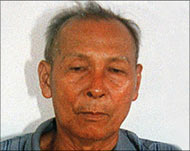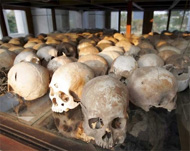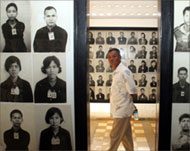Cambodia’s long wait for justice
It seems strange to describe the passing of a man known as “the Butcher” – the military chief of a movement that killed over one and a half million people – as a shame.

Yet that is how many are referring to the death in detention last month of Ta Mok, the one time military commander-in-chief of Cambodia’s Khmer Rouge regime.
Led by Pol Pot, the so-called “Brother Number One”, the four years of Khmer Rouge rule between 1975 and 1979 saw the genocide of between 1.5 and three million Cambodians in the notorious “killing fields”.
Pol Pot himself died of apparently natural causes in 1998 in his jungle hideout.
Now survivors and relatives of those massacred by his radical communist movement fear that Ta Mok’s death will only further undermine a long-delayed UN tribunal aimed at delivering them some semblance of justice.
|
CAMBODIA TIMELINE 1975 – Khmer Rouge seize power, Year Zero begins. |
Supporters of the tribunal say the process is necessary for Cambodia to move on and reconcile itself with the horrors that were committed.
In early July this year, after much international hand-wringing, the tribunal process finally got under way with the swearing in of 17 Cambodian and 10 foreign judges.
They have a three-year mandate to investigate the few surviving members of the Khmer Rouge.
Those in the spotlight include 64-year-old Kang Kek Ieu, known as “Duch”, the former head of the notorious Tuol Sleng prison – a one-time high school converted into a Khmer Rouge torture center.
Duch is now the only senior Khmer Rouge leader currently held in detention.
Another senior “Brother” under investigation is Nuon Chea, Pol Pot’s number two, who lives freely in Pailin, the regime’s former capital near the Thai border.
Helen Jarvis, the chief of public affairs for the tribunal told Aljazeera that Ta Mok’s death would not impact on the daily work of the investigation, as he was not under the jurisdiction of the court.
Evidence
 |
|
‘Brother Number One’ Pol Pot |
Making up the UN tribunal are two levels of court with the investigating judges due to begin their work in September before issuing preliminary requests of investigation.
Only then, if there is sufficient evidence, will trial proceedings begin against those indicted.
That could take place in early 2007, but a series of problems have beset the tribunal including haggling over the number of local judges while the Cambodian government is still to stump up their part of the $56.3 million budget.
Jarvis understands the frustration of those eager to see justice but expects to see defendants in the dock in the first part of next year.
The tribunal, she says, must be seen to be transparent and adhering to the letter of the law.
“Of course every time the course of justice is cut short it is a blow,” she says. “But what’s the alternative? Until indictments are issued the proper legal process needs to be followed. It is vital these people have the proper mandate.”
It is not a feeling shared by Ta Mok’s former lawyer, Cambodian Benson Samay.
“I don’t talk about the Khmer Rouge anymore,” was his curt response to inquiries.
Torture
 |
|
Ta Mok’s bloody reputation earned |
Youk Chhang, Director of the Documentation Centre of Cambodia in Phnom Penh, has dedicated many years working to ensure this sentiment does not become widespread and that Cambodians are able to understand the true horrors of their past.
His centre has collected around 600,000 pages of documentation from the Khmer Rouge era, including thousands of photographs of detainees at the Tuol Sleng torture center – only a handful of whom survived.
Chhang agrees that the death of Ta Mok will have no practical effect on the justice process but says it has “had an impact on national reconciliation.”
The judges, he says, must continue their work.
|
“There are still good reasons to push forward” |
“People can find out what really happened, there are still good reasons to push forward.”
Around 25% of Cambodia’s current population was not even born when the genocide took place.
Aljazeera journalist Stephanie Scawen has spent many years “chasing the Khmer Rouge” and says while most young people know either a relative or someone else who was killed, many “don’t believe their own people could do this to one another”.
Year Zero
 |
|
Hundreds of thousands died in |
Presenting itself as a peaceful alternative to the pro-US government of General Lon Nol, Pol Pot’s China-backed Khmer Rouge captured Phonm Penh in April 1975 and embarked on mass urban evacuation in an effort to transform the country into their vision of an agrarian utopia.
The start of what was dubbed “Year Zero” heralded a killing spree that targeted anyone associated with the old regime or perceived to be an opponent of the new one.
Many of those purged came from the educated classes. Some were killed for as trivial a sin as wearing spectacles because they were seen as a symbol of US intellectualism.
As many as three million were eradicated, almost a third of the population at the time, with many dying from overwork and starvation.
Some, including Chhang, equate Cambodia coming to terms with the “killing fields” with Germany confronting and reconciling itself with its Nazi past.
Criticism
 |
|
Pictures of victims adorn the |
However schoolchildren today are taught remarkably little about the period. The country is beset by social problems including poverty and the government faces increasing criticism for its record on human rights.
Ou Varek, a prominent human rights activist, told Aljazeera he suspects information about the true horror of the genocide is often suppressed by the current government to hide any involvement in the Khmer Rouge regime.
Hun Sen, the prime minister since 1985, was himself a member of the Khmer Rouge but fled to Vietnam. He was installed by the Vietnamese after their invasion of Cambodia in 1979 which ousted the Khmer Rouge from power.
In the years that followed, with the remnants of the Khmer Rouge fighting a bitter resistance war, many junior and middle-ranking Khmer Rouge officers were all but let-off as part of a government amnesty designed to erode the group’s power.
Defeat
When the movement was finally defeated in the late 1990s, only the few surviving cadres from Pol Pot’s inner circle were detained.
In 1997, shortly before Pol Pot died, a Khmer Rouge Trial Task Force was finally created, but even then progress remained painfully slow.
The large number of mourners at Ta Mok’s funeral and the fact that Nuon Chea and others live freely in the north-west of Cambodia near the Thai border are testament to the challenges that remain.
Helen Jarvis insists current legal proceedings and the death of Ta Mok must be put in a wider international geo-political context and that the tribunal is still the best way to finally ensure justice is done.
“Everyone is frustrated and in a hurry, but you cannot make up for 30 years in a matter of weeks.”